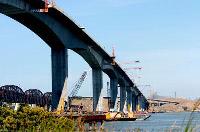By Matthias Gafni/Times-Herald, Vallejo
TheReporter.Com

Construction continues on the Benicia-Martinez Bridge with plans calling for its completion in October 2007. (Times-Herald, Vallejo photo/J.L. Sousa)
When you're building a bridge and unexpectedly encounter exploding salmon, fracturing rock and feverish concrete, you can expect delays and cost overruns.
So goes the Benicia-Martinez Bridge project more than three years after its first targeted completion date - and about $1 billion over budget.
It's been a tough ride for Caltrans engineers and bridge builder Kiewit Pacific's workers, who have had to endure one problem after another.
'In our business, there are no problems, only challenges,' smiles Richard Foley, Caltrans senior bridge engineer, as he stands hundreds of feet above the Carquinez Strait atop the new concrete skyway.
The new bridge, just southeast of the current span, is now scheduled to open to motorists in October 2007, with a $1.26 billion price tag.
'We feel very comfortable with the cost we have and the schedule is looking very positive,' said Mo Pazooki, Caltrans project manager for the bridge.

Carpenter Jose Rodriquez works Thursday morning on the Benicia-Martinez Bridge. (Times-Herald, Vallejo photo/J.L. Sousa)
About 30 government officials toured the bridge and its toll plaza Thursday, getting an up-close look at the large concrete skyway bridge and an update on progress. Interested parties discussed traffic concerns, economic impacts, project obstacles and the science behind bridge building.
As the group stood on the deck of the new span, with all its sections nearly attached, they could spy the Alfred Zampa Memorial Bridge to the northwest. That new Carquinez Bridge was a Caltrans tour de force. It marked the first suspension bridge built in the United States since 1973, and more importantly to many, it came in on budget and on time.
Construction on the Alfred Zampa bridge began after work started on the Benicia-Martinez Bridge. Yet, at $480 million in cost, it was finished in 2003.
Pazooki says the two bridge projects are apples and oranges.
Besides the strait being significantly wider near the Benicia-Martinez site, numerous other issues surfaced during construction.
Pazooki pointed to three major problems:
• pile driving that threatened salmon
• a softer-than-expected rock beneath the strait, and
• a heat-and-hydration issue with the lightweight concrete.
The first issue arose when officials realized sound waves from pile driving were causing protected salmon to explode.
Bridge officials created an air bubble system that reduced the driving noise , solving the issue and pioneering a new bridge building technique, Pazooki said. But delays consumed 18 months and costs soared $250 million.
As crews drove steel piles into the murky strait, they quickly realized the rock wasn't nearly as sturdy as expected. That necessitated another steel sleeve to slip inside the pile, while the concrete was poured, and then removed.
Finally, the Benicia bridge, because of distance between piers, needed a lightweight concrete mixture. Crews quickly found it, and it weighs about one-fifth less than normal concrete, but rose to extremely hot temperatures during the hardening process, causing minor cracks.
A cooling system was implemented. As the concrete is mixed, it's cooled with ice, then crews insert liquid nitrogen into the concoction. Once the concrete is laid and curing, water is pumped through pipes embedded in the concrete to cool it.
Solano Transportation Authority Executive Director Daryl Halls said on major projects unexpected problems cause serious delays 'and with more time, materials and labor costs only can go up.
'$1.2 billion - that's a lot,' Halls said. 'The longer you wait to build it, the more costly it gets."
Despite previous delays, Pazooki said he expects smooth sailing until the finish.
A year ago, Caltrans estimated the bridge would open in December 2007, but he now anticipates an opening that October.
To help, Caltrans has dangled a carrot to bridge builder Kiewet Pacific, offering a $1 million incentive for each month it finishes before December 2007, up to three months. The builder has workers averaging 20-hour work days, six days a week, officials said.
Once open, the new span will handle only northbound traffic, with five lanes. The current span will get a facelift and then handle all southbound traffic, with four lanes. It's expected to take two years to refurbish the old bridge.
